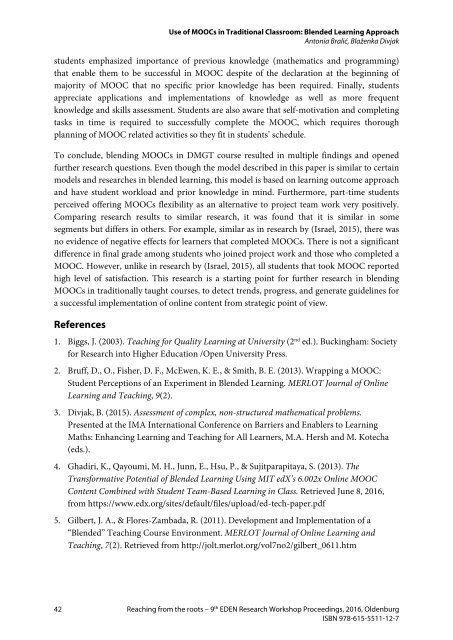Forging new pathways of research and innovation in open and distance learning
RW_2016_Oldenburg_Proceedings
RW_2016_Oldenburg_Proceedings
You also want an ePaper? Increase the reach of your titles
YUMPU automatically turns print PDFs into web optimized ePapers that Google loves.
Use <strong>of</strong> MOOCs <strong>in</strong> Traditional Classroom: Blended Learn<strong>in</strong>g Approach<br />
Antonia Bralić, Blaženka Divjak<br />
students emphasized importance <strong>of</strong> previous knowledge (mathematics <strong>and</strong> programm<strong>in</strong>g)<br />
that enable them to be successful <strong>in</strong> MOOC despite <strong>of</strong> the declaration at the beg<strong>in</strong>n<strong>in</strong>g <strong>of</strong><br />
majority <strong>of</strong> MOOC that no specific prior knowledge has been required. F<strong>in</strong>ally, students<br />
appreciate applications <strong>and</strong> implementations <strong>of</strong> knowledge as well as more frequent<br />
knowledge <strong>and</strong> skills assessment. Students are also aware that self-motivation <strong>and</strong> complet<strong>in</strong>g<br />
tasks <strong>in</strong> time is required to successfully complete the MOOC, which requires thorough<br />
plann<strong>in</strong>g <strong>of</strong> MOOC related activities so they fit <strong>in</strong> students’ schedule.<br />
To conclude, blend<strong>in</strong>g MOOCs <strong>in</strong> DMGT course resulted <strong>in</strong> multiple f<strong>in</strong>d<strong>in</strong>gs <strong>and</strong> <strong>open</strong>ed<br />
further <strong>research</strong> questions. Even though the model described <strong>in</strong> this paper is similar to certa<strong>in</strong><br />
models <strong>and</strong> <strong>research</strong>es <strong>in</strong> blended learn<strong>in</strong>g, this model is based on learn<strong>in</strong>g outcome approach<br />
<strong>and</strong> have student workload <strong>and</strong> prior knowledge <strong>in</strong> m<strong>in</strong>d. Furthermore, part-time students<br />
perceived <strong>of</strong>fer<strong>in</strong>g MOOCs flexibility as an alternative to project team work very positively.<br />
Compar<strong>in</strong>g <strong>research</strong> results to similar <strong>research</strong>, it was found that it is similar <strong>in</strong> some<br />
segments but differs <strong>in</strong> others. For example, similar as <strong>in</strong> <strong>research</strong> by (Israel, 2015), there was<br />
no evidence <strong>of</strong> negative effects for learners that completed MOOCs. There is not a significant<br />
difference <strong>in</strong> f<strong>in</strong>al grade among students who jo<strong>in</strong>ed project work <strong>and</strong> those who completed a<br />
MOOC. However, unlike <strong>in</strong> <strong>research</strong> by (Israel, 2015), all students that took MOOC reported<br />
high level <strong>of</strong> satisfaction. This <strong>research</strong> is a start<strong>in</strong>g po<strong>in</strong>t for further <strong>research</strong> <strong>in</strong> blend<strong>in</strong>g<br />
MOOCs <strong>in</strong> traditionally taught courses, to detect trends, progress, <strong>and</strong> generate guidel<strong>in</strong>es for<br />
a successful implementation <strong>of</strong> onl<strong>in</strong>e content from strategic po<strong>in</strong>t <strong>of</strong> view.<br />
References<br />
1. Biggs, J. (2003). Teach<strong>in</strong>g for Quality Learn<strong>in</strong>g at University (2 nd ed.). Buck<strong>in</strong>gham: Society<br />
for Research <strong>in</strong>to Higher Education /Open University Press.<br />
2. Bruff, D., O., Fisher, D. F., McEwen, K. E., & Smith, B. E. (2013). Wrapp<strong>in</strong>g a MOOC:<br />
Student Perceptions <strong>of</strong> an Experiment <strong>in</strong> Blended Learn<strong>in</strong>g. MERLOT Journal <strong>of</strong> Onl<strong>in</strong>e<br />
Learn<strong>in</strong>g <strong>and</strong> Teach<strong>in</strong>g, 9(2).<br />
3. Divjak, B. (2015). Assessment <strong>of</strong> complex, non-structured mathematical problems.<br />
Presented at the IMA International Conference on Barriers <strong>and</strong> Enablers to Learn<strong>in</strong>g<br />
Maths: Enhanc<strong>in</strong>g Learn<strong>in</strong>g <strong>and</strong> Teach<strong>in</strong>g for All Learners, M.A. Hersh <strong>and</strong> M. Kotecha<br />
(eds.).<br />
4. Ghadiri, K., Qayoumi, M. H., Junn, E., Hsu, P., & Sujitparapitaya, S. (2013). The<br />
Transformative Potential <strong>of</strong> Blended Learn<strong>in</strong>g Us<strong>in</strong>g MIT edX’s 6.002x Onl<strong>in</strong>e MOOC<br />
Content Comb<strong>in</strong>ed with Student Team-Based Learn<strong>in</strong>g <strong>in</strong> Class. Retrieved June 8, 2016,<br />
from https://www.edx.org/sites/default/files/upload/ed-tech-paper.pdf<br />
5. Gilbert, J. A., & Flores-Zambada, R. (2011). Development <strong>and</strong> Implementation <strong>of</strong> a<br />
“Blended” Teach<strong>in</strong>g Course Environment. MERLOT Journal <strong>of</strong> Onl<strong>in</strong>e Learn<strong>in</strong>g <strong>and</strong><br />
Teach<strong>in</strong>g, 7(2). Retrieved from http://jolt.merlot.org/vol7no2/gilbert_0611.htm<br />
42 Reach<strong>in</strong>g from the roots – 9 th EDEN Research Workshop Proceed<strong>in</strong>gs, 2016, Oldenburg<br />
ISBN 978-615-5511-12-7


